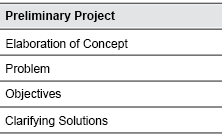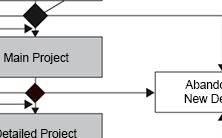The concept of phases
Preliminary work
Initiation of project
The initiation of a project is the period of time between acknowledging a problem and deciding to do something about it. At this rather unstructured stage you collect literature and ideas; the questions posed can still be vague. However, it is already possible to concretize certain steps such as contacting and choosing your mentors or supervisors. In addition, we recommend a project agreement between student and mentor during this stage. Both determine general objectives and expectations while identifying any potential conflicts. This agreement also contains specific requirements such as important milestones (e.g. presentation of concept and results), available resources, and deadlines (organization of empirical research, temporary submission date) (Witschi 1999: 1). A bar chart can be used as a visual aid for your timing, each sub-step relating to a limited period of time.
Project agreements determine general objectives.
Preliminary project
At this stage a provisional concept is prepared while concretizing further steps and timing (fig. 5). The problem, its limitations, and methods are defined more accurately while clarifying the current state of research. Under ideal conditions you can eventually present a concept during a seminar or colloquium.
Realization
Main project
At this stage you focus on developing a master plan. It is advisable to allow enough time for familiarizing yourself with all relevant theories, arguments, and methods. Afterwards we recommend a detailed review and possible revision, since you set important guidelines for the subsequent data collection at this point.
Detailed project
Here you determine the general conditions for empirical research when operationalizing terms, determining indicators, forming hypotheses, and creating a guide or questionnaire according to requirements. At the end of this stage, it is necessary to make a pretest in order to calibrate the following data collection.
If possible you should pretest the methods selected.
System building
System building in its broadest sense refers to «building» solutions. In relation to a master's thesis, these are the steps when collecting and analyzing data. According to your research model these steps are concurrent and interacting operations when e.g. including provisional results in your data collection.
After completing your project, it is common practice to review your work with a discussion or assessment. However, it is also worthwhile to think about the entire working process, its good as well as its problematic aspects. Usually during university studies you have to write only one or two larger text bodies, but having some experience in project planning is also of value after graduation. On a smaller scale, some of the steps mentioned above will be helpful when writing a term paper.
We recommend beginning to write early while planning some time for revisions.
Application
Realization
In case there is a possibility to make your paper or certain parts of it public, you should seize the opportunity. Turning the paper's or thesis's results into articles, workshops or talks grants access for a wider audience. Additionally, you can gain experience regarding the distribution of research results.
Milestones
It is important to have milestones since they set the course for the project's next steps. When looking at the figure regarding the concept of phases (cf. fig. 6), you realize that the milestones' size (symbolizing their importance) will decrease gradually. The bigger the progress of a project, the lower is the degree of probability to terminate or re-define. This means that you have to think long and hard about the feasibility of the project's next steps, especially at the very beginning.
Milestones will make it easier to structure your workload.

